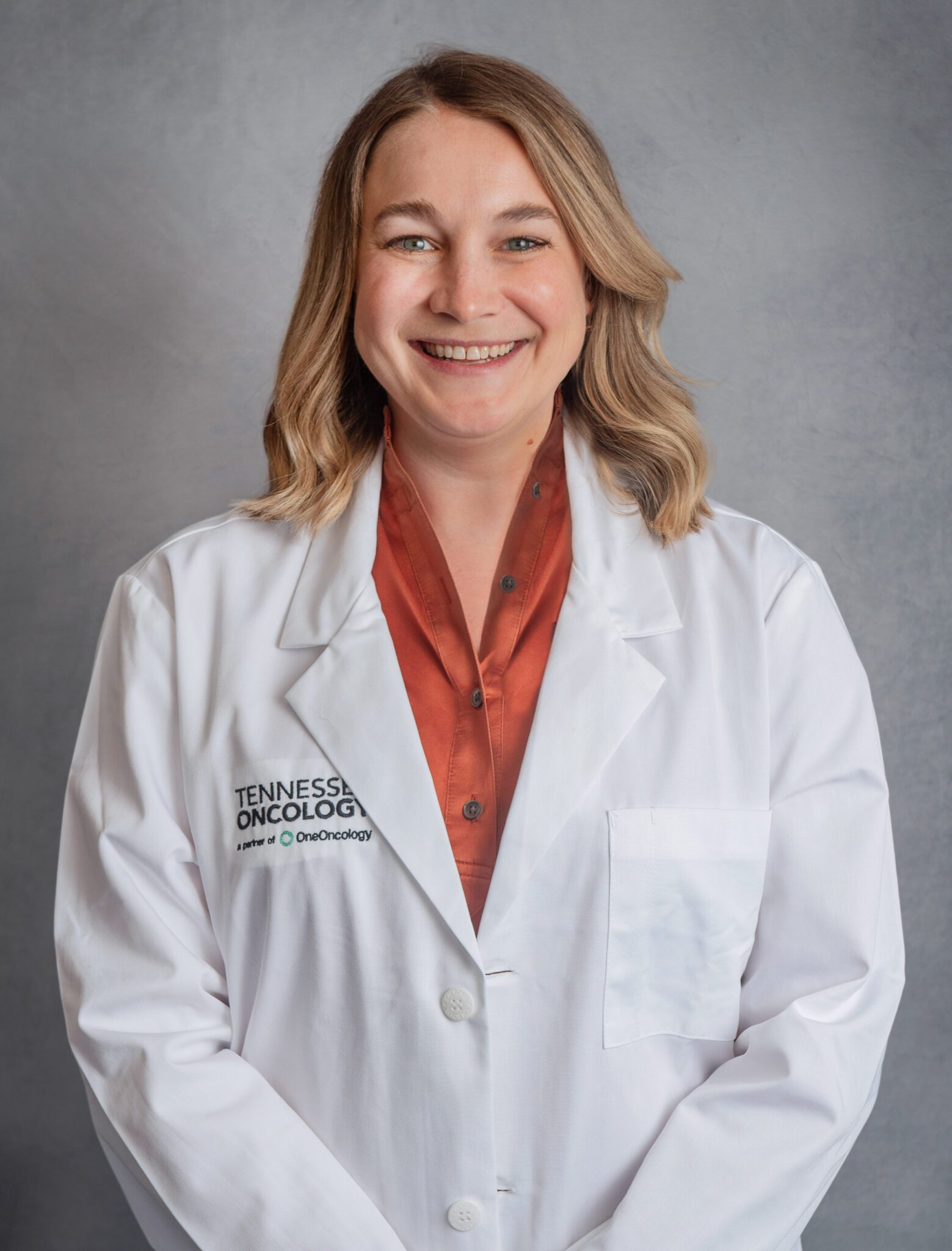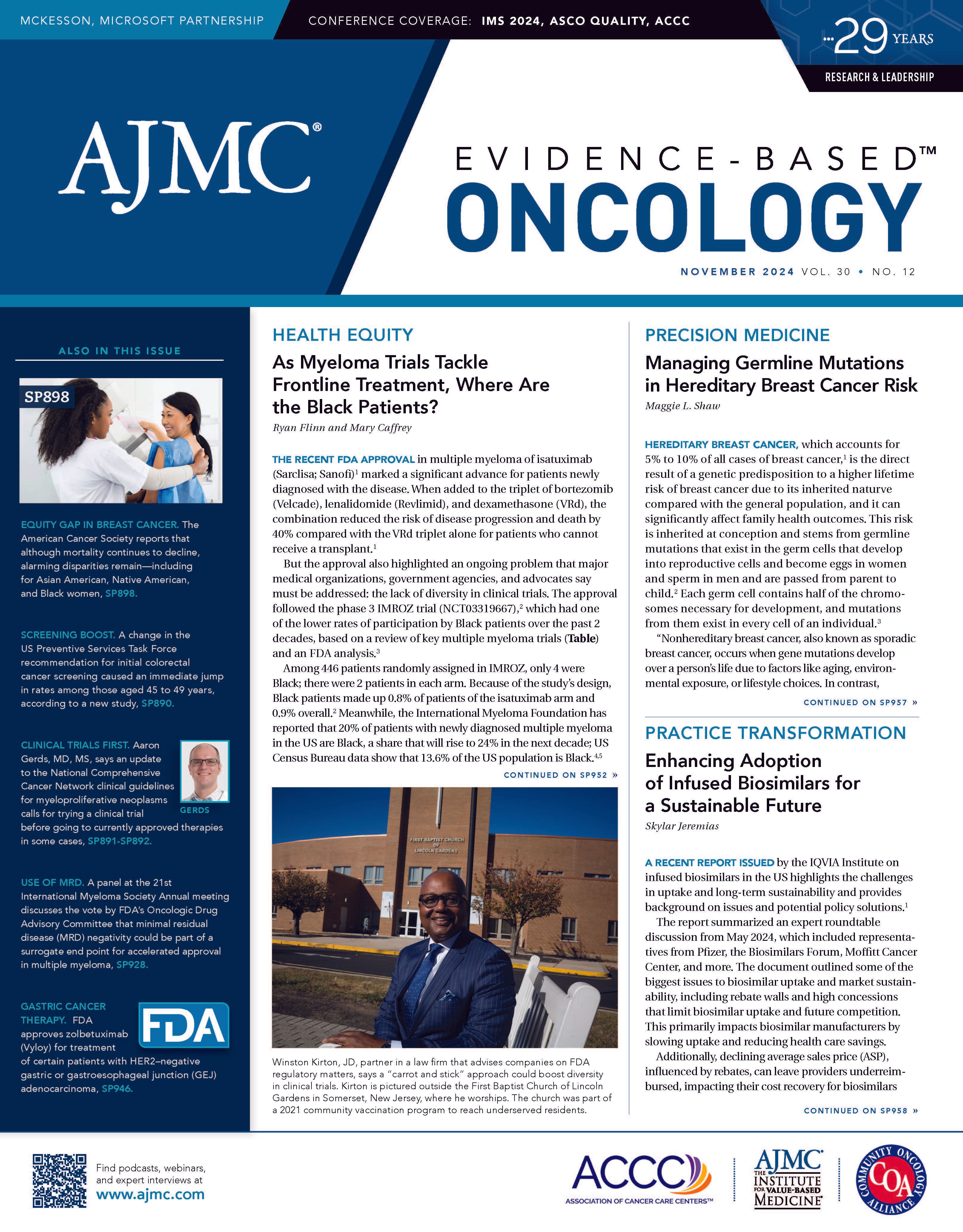- Center on Health Equity & Access
- Clinical
- Health Care Cost
- Health Care Delivery
- Insurance
- Policy
- Technology
- Value-Based Care
Managing Germline Mutations in Hereditary Breast Cancer Risk
Hereditary breast cancers are caused by germline mutations, which are genetic mutations inherited at conception and so called because they originate in germ cells, those that develop into reproductive cells and become eggs in female individuals and sperm in male individuals.
Hereditary breast cancer, which accounts for 5% to 10% of all cases of breast cancer,1 is the direct result of a genetic predisposition to a higher lifetime risk of breast cancer due to its inherent inherited nature compared with the general population, and it can significantly affect family health outcomes. This risk is inherited at conception and stems from germline mutations that exist in the germ cells that develop into reproductive cells and become eggs in female individuals and sperm in male individuals and are passed from parent to child.2 Each germ cell contains half of the chromosomes necessary for development, and mutations from them exist in every cell of an individual.3
Kate Baker, MD, MMHC | Image Credit: © Tennessee Oncology

“Nonhereditary breast cancer, also known as sporadic breast cancer, occurs when gene mutations develop over a person’s life due to factors like aging, environmental exposure, or lifestyle choices. In contrast, hereditary breast cancer is caused by mutations inherited from one or both parents,” explained Kate Baker, MD, MMHC, medical director of value-based care and medical oncologist, Tennessee Oncology, in an interview with The American Journal of Managed Care® (AJMC®). “The mutations typically affect specific genes responsible for regulating how cells grow, divide, or repair damaged DNA, and disruption of these key processes is what leads to the development of breast cancer.”
Understanding the genetic factors involved in hereditary breast cancer is crucial for early detection, risk assessment, and informed decision-making about preventive measures. By identifying individuals at high risk, there is greater ability to provide targeted treatment interventions that are also effective, thereby significantly improving patient outcomes and ultimately offering more personalized treatment options and preventive strategies for those affected by hereditary breast cancer.
Genes Implicated in Hereditary Breast Cancer
The genes that are most often implicated in hereditary breast cancer, and perhaps that are the most well known for that reason, are BRCA1 and BRCA2. Women found to have these genes can have a 55% to 58% greater risk of developing breast cancer in their lifetime compared with 12.5% among the general population, explained Samyukta Mullangi, MD, MBA, medical director at Thyme Care and medical oncologist with Tennessee Oncology. This hereditary risk can be even higher if a first-degree relative has received a breast cancer diagnosis, she added, or if there is a family history of “related” cancers that include ovarian, pancreatic, or prostate cancer.
Samyukta Mullangi, MD, MBA | Image Credit: © Tennessee Oncology

When these DNA repair genes are not damaged, or mutated, they help to prevent harmful mutations from accumulating in our genomes and keep cells healthy across different tissues, explained Baker. However, these 2 genes also are known to give rise to other cancers in both women and men when damaged copies of them are present—because although it is less common, men can also develop breast cancer—which makes identifying them all the more important. Among female individuals, beyond breast cancer, there is a known higher risk for developing ovarian cancer, and among male individuals, there are established associations between the inheritance of BRCA1 and BRCA2 and the development of prostate cancer.4
“Genes can be passed equal to male or female [individuals],” explained Karen Kostroff, MD, chief of breast surgery at Northwell Health, who specializes in the diagnosis and treatment of hereditary breast cancer among women, to AJMC. “They are not tied to sex. But men still have a lesser chance of getting breast cancer.”
Karen Kostroff, MD | Image Credit: © Northwell Health

Beyond the risk contributions from the well-known BRCA1 and BRCA2, there are several less common inherited genes that are to blame for a greater risk of developing hereditary breast cancer, as well as other cancers, according to Mullangi. These genes are TP53, PTEN, PALB2, CHEK2, and ATM, she told AJMC, and they are all tumor suppressor genes.
The function of tumor suppressor genes is to regulate uncontrolled cell proliferation. Therefore, when they are mutated, cells can grow and proliferate unencumbered, “and this unchecked cell growth can lead to the formation of cancer as the body loses its ability to regulate cell activity,” Baker added.
Mullangi elaborated on the specific cancers linked to each of these gene mutations, emphasizing their varying degrees of risk and the broad spectrum of malignancies they influence, including rare and aggressive cancers:
- Mutated TP53 has been associated with the rare genetic autosomal dominant disorder Li-Fraumeni syndrome, which is associated with a 90% chance of developing 1 or more cancers over a lifetime and a 50% chance before age 30; these cancers include osteosarcoma, gliomas, leukemia, and breast cancer.5
- Mutated PTEN is linked with Cowden syndrome, another rare inherited disorder, which confers a higher risk of melanoma, thyroid, endometrium, and breast cancers.6
- PALB2 is a partner to BRCA2, Mullangi explained, and is involved in DNA damage repair; when this gene is mutated, women have a 35% greater risk of developing breast cancer before age 70,7 and there are higher risks of ovarian, prostate, and pancreatic cancers.8
- CHEK2 mutations increase breast cancer risk in both women and men—although this varies according to the mutation—as well as confer a greater risk of prostate cancer.9
- A mutated ATM gene can cause ataxia-telangiectasia, which is inherited from both parents, and disrupts the nervous and immune systems; however, just 1 inherited mutation is sufficient to increase risks for cancers that include breast, pancreatic prostate, and ovarian cancers.10
Genetic Testing for Hereditary Breast Cancer
In order to test for genes that increase the risk of developing hereditary breast cancer, germline testing, also known as biomarker testing, is necessary, and it is performed on cells that do not have cancer. These tests most often utilize blood samples,11 but can also use saliva and tissue, Mullangi explained, and they help to detect harmful pathogenic or likely pathogenic variants12—not all pathogenic variants lead to disease; identified variants can also be classified as benign, likely benign, or a variant of uncertain significance.13
Genetic testing is crucial for those meeting certain criteria, explained Kostroff.
However, many patients who could benefit from knowing their genetic risk for developing hereditary cancer do not even undergo germline testing, with restrictive germline genetic testing guidelines being to blame.14-16 Cost can also be a significant factor, with genetic tests often having high prices—from less than $100 to $2000 and above17—that are unaffordable for many and may not be covered by insurance for others, limiting access for certain populations. Research shows that rates for genetic testing remain far below the recommended levels from practice guidelines.11
So, what are the guideline recommendations for who should undergo germline genetic testing for hereditary breast cancer?
As a baseline, all women should under a breast cancer risk assessment by age 25, according to the American College of Radiology, especially those considered high risk, who include Black and Ashkenazi Jewish women. Black women are 40% more likely to die from breast cancer and BRCA1 and BRCA2 mutations are much more common in Ashkenazi Jewish women compared with the general population.18
Receiving a cancer diagnosis at a young age—which is usually considered to be younger than 50 years, highlighted Mullangi—is another important criterion. So, too, is having a personal and/or family history of the same cancer or a related cancer, she added, and with which Kostroff concurred. Cancers covered under this umbrella include triple-negative, metastatic, and male breast cancer; ovarian, pancreatic, and metastatic prostate cancers; medullary thyroid carcinoma; and pheochromocytoma or paraganglioma.11,19 Germline testing rates for several of these cancers remain at suboptimal levels; for example, just 26% of women with breast cancer have undergone germline testing.11
Baker elaborated on this guidance, noting, “The National Comprehensive Cancer Network recommends genetic testing for genes that cause hereditary breast cancer for anyone that has a close blood relative with breast cancer diagnosed earlier than age 50 or a male relative with breast cancer. Additionally, genetic testing is recommended when a patient has more than 3 blood relatives on the same side of the family with a diagnosis of breast cancer.”
Many experts would like to see universal germline testing, as that can widen access to necessary targeted treatments and clinical trial enrollment.14 However, some insurance companies will only cover the cost of testing if a patient is considered high risk, Kostroff explained, such as in the case of patients diagnosed with triple-negative disease.
Meanwhile, there are patients who opt to foot the bill for genetic testing, “even though on paper they have zero risk factors. These patients want to know everything about their body,” she added.
The experts interviewed for this article agreed that risk reduction strategies, coupled with screening, should be individualized per patient based on their genetic risk and personal preferences.
References
1. What causes hereditary breast and ovarian cancers. CDC. August 28, 2024. Accessed October 5, 2024. https://www.cdc.gov/breast-ovarian-cancer-hereditary/causes/index.html#:~:text=to%20fighting%20cancer.-,Hereditary%20breast%20and%20ovarian%20cancer,from%20your%20mother%20or%20father
2. Germ cell. National Cancer Institute. Accessed October 5, 2024. https://www.cancer.gov/publications/dictionaries/cancer-terms/def/germ-cell
3. Germline mutation. National Cancer Institute. Accessed October 5, 2024. https://www.cancer.gov/publications/dictionaries/cancer-terms/def/germline-mutation
4. Inherited cancer risk: BRCA mutation. Johns Hopkins Medicine. Accessed October 5, 2024. https://www.hopkinsmedicine.org/health/conditions-and-diseases/breast-cancer/inherited-cancer-risk-brca-mutation#:~:text=Inheriting%20damaged%20copies%20of%20the,as%20well%20as%20other%20cancers
5. Li-Fraumeni syndrome. Cleveland Clinic. Accessed October 5, 2024. https://my.clevelandclinic.org/health/diseases/22073-li-fraumeni-syndrome
6. Cowden syndrome. National Cancer Institute. Accessed October 5, 2024. https://www.cancer.gov/publications/dictionaries/cancer-terms/def/cowden-syndrome
7. Antoniou AC, Casadei S, Keikkinen T, et a. Breast-cancer risk in families with mutations in PALB2. N Engl J Med. 2014;371(6):497-506. doi:10.1056/NEJMoa1400382
8. Liu D. PALB2. City of Hope. Updated December 1, 2022. Accessed October 5, 2024. https://www.cancercenter.com/cancer-types/breast-cancer/risk-factors/palb2#:~:text=PALB2%20gene%20mutation?-,What%20is%20PALB2?,its%20connection%20to%20breast%20cancer
9. CHEK2 gene mutations: cancer risk. Facing Our Risk of Cancer Empowered. Accessed October 5, 2024. https://www.facingourrisk.org/info/hereditary-cancer-and-genetic-testing/hereditary-cancer-genes-and-risk/genes-by-name/chek2/cancer-risk
10. About mutations in the ATM gene. Memorial Sloan Kettering Cancer Center. Updated July 17, 2023. Accessed October 5, 2024. https://www.mskcc.org/cancer-care/patient-education/about-mutations-atm-gene
11. McGrath D. Few people with cancer undergo testing for inherited gene mutations. National Cancer Institute. August 1, 2023. Accessed October 6, 2024. https://www.cancer.gov/news-events/cancer-currents-blog/2023/germline-testing-for-cancer-underused
12. Most “pathogenic” genetic variants have a low risk of causing disease. News release. Mount Sinai. January 25, 2022. Accessed October 6, 2024. https://www.mountsinai.org/about/newsroom/2022/most-pathogenic-genetic-variants-have-a-low-risk-of-causing-disease
13. Do all gene variants affect health and development? MedlinePlus. Updated March 25, 2021. Accessed October 6, 2024. https://medlineplus.gov/genetics/understanding/mutationsanddisorders/neutralmutations/#:~:text=Pathogenic:%20The%20variant%20is%20responsible,the%20research%20may%20be%20conflicting
14. WhitworthPW, Beitsch PD, Patel R, et al. Clinical utility of universal germline genetic testing for patients with breast cancer. JAMA Netw Open. 2022;5(9):e2232787. doi:10.1001/jamanetworkopen.2022.32787
15. Beitsch PD, Whitworth PW, Hughes K, et al. Underdiagnosis of hereditary breast cancer: are genetic testing guidelines a tool or an obstacle? J Clin Oncol. 2018;37(6):453-460. doi:10.1200/JCO.18.01631
16. Kurian AW, Abrahamse P, Furgal A, et al. Germline genetic testing after cancer diagnosis. JAMA. 2023;330(1):43-51. doi:10.1001/jama.2023.9526
17. DePolo J. Genetic testing for breast cancer. Breastcancer.org. Accessed October 6, 2024. https://www.breastcancer.org/genetic-testing
18. DePolo J. New ACR guidelines say all women should have breast cancer risk assessment by age 25. Breastcancer.org. May 9, 2023. Accessed October 7, 2024. https://www.breastcancer.org/research-news/acr-2023-screening-guidelines
19. Indications for germline testing in cancer patients. The Jackson Laboratory. Updated October 2021. Accessed October 7, 2024. https://www.jax.org/education-and-learning/clinical-and-continuing-education/clinical-topics/tumor-testing/germlinetest#

